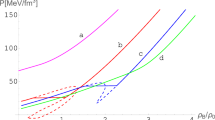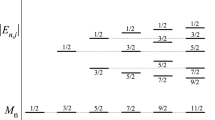Abstract
A Fermi-gas model for the atomic nucleus in the presence of a quantizing magnetic field is considered. The energy of the magnetized neutrons is determined taking into account the Pauli paramagnetism, and the energy of the magnetized protons taking into account Landau diamagnetism and Pauli paramagnetism. To determine the characteristics of the proton-gas energy in a quantizing magnetic field, we use a model for the proton motion in which the initial energy of the proton and the magnetic field strength enable estimation of the maximum Landau quantum number. The latter characterizes the proton motion perpendicular to the direction of the magnetic field. Due to the occupation of Landau levels by protons, it is possible to estimate the kinetic energy for continuous motion along the magnetic field from zero to a certain finite value. As a result, the magnetic field of a certain strength facilitates neutron evaporation from the nucleus and increases the stability of the protons in the nucleus.
Similar content being viewed by others
References
G. S. Saakyan, Equilibrium Configurations of Degenerate Gas Masses (Nauka, Moscow, 1978), p. 97 [in Russian].
N. G. Bochkarev, Magnetic Fields in the Cosmos (Nauka, Moscow, 1985), p. 143 [in Russian].
G. S. Bisnovatyi-Kogan, Yu. P. Popov, and A. A. Samokhin, Astrophys. Space Sci. 41, 321 (1976).
G. S. Bisnovatyi-Kogan, Physical Problems in the Theory of Stellar Evolution (Nauka, Moscow, 1989), p. 330 [in Russian].
G. A. Shul’man, Yad. Fiz. 64, 370 (1991) [Phys. At. Nucl. 54, 322 (1991)].
G. A. Shul’man, DoctoralDissertation in Mathematical Physics (Inst. Fiziki AN Belorussii, Minsk, 1992).
G. A. Shul’man, Astron. Zh. 53, 755 (1976) [Sov. Astron. 20, 425 (1976)].
G. A. Shul’man, Astron. Zh. 53, 1218 (1976) [Sov. Astron. 20, 689 (1976)].
G. A. Shul’man, Astron. Zh. 54, 1041 (1977) [Sov. Astron. 21, 590 (1977)].
G. A. Shul’man, Astron. Zh. 66, 758 (1989) [Sov. Astron. 33, 393 (1989)].
G. A. Shul’man, Astron. Zh. 67, 334 (1990) [Sov. Astron. 34, 167 (1990)].
G. A. Shul’man, Izv. Vyssh. Uchebn. Zaved., Ser. Fiz., No. 1, 102 (1994).
G. A. Shul’man, Izv. Vyssh. Uchebn. Zaved., Ser. Fiz., No. 2, 14 (1999).
G. A. Shul’man, Izv. Vyssh. Uchebn. Zaved., Ser. Fiz., No. 2, 50 (1999).
V. O. Maslennikov and G. A. Shul’man, Izv. Vyssh. Uchebn. Zaved., Ser. Fiz., No. 7, 31 (1999).
V. O. Maslennikov, A. N. Pankrat’eva, and G. A. Shul’man, Izv. Vyssh. Uchebn. Zaved., Ser. Fiz., No. 5, 3 (2001).
G. A. Shul’man and V. S. Kostko, Izv. Vyssh. Uchebn. Zaved., Ser. Fiz., No. 10, 3 (2006).
B. M. Askerov, Electron Transport Phenomena In Semiconductors (Nauka, Moscow, 1985; World Sci., Singapore, 1994), p. 224.
G. A. Shul’man, Astron. Zh. 68, 101 (1991) [Sov. Astron. 35, 50 (1991)].
G. A. Shul’man, Astron. Zh. 69, 116 (1992) [Sov. Astron. 36, 58 (1992)].
W. Pauli, Works on Quantum Theory (Nauka, Moscow, 1977), p. 134 [in Russian].
M. S. Svirskii, Fiz. Met. Metalloved. 15, 635 (1963).
S. V. Vonsovskii, Magnetism (Nauka, Moscow, 1971; Wiley, New York, 1971).
H. Frauenfelder and E. Henley, Subatomic Physics (Prentice-Hall, Englewood Cliffs, NJ, 1974; Mir, Moscow, 1979).
L. D. Landau and E. M. Lifshitz, Course of Theoretical Physics, Vol. 3: Quantum Mechanics: Non-Relativistic Theory (Nauka, Moscow, 1989, 4th ed.; Pergamon, New York, 1977, 3rd ed.).
V. S. Kostko and G. A. Shul’man, Izv. Vyssh. Uchebn. Zaved., Ser. Fiz., No. 3, 18 (2005).
Author information
Authors and Affiliations
Additional information
Original Russian Text © G.A. Shul’man, 2011, published in Astronomicheskii Zhurnal, 2011, Vol. 88, No. 3, pp. 295–302.
Rights and permissions
About this article
Cite this article
Shul’man, G.A. The theory of bypassed-isotope formation in the universe. Astron. Rep. 55, 267–274 (2011). https://doi.org/10.1134/S1063772911020065
Received:
Accepted:
Published:
Issue Date:
DOI: https://doi.org/10.1134/S1063772911020065




